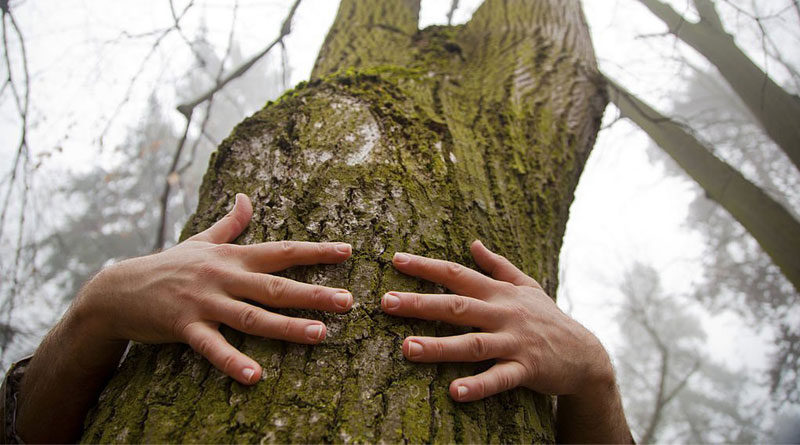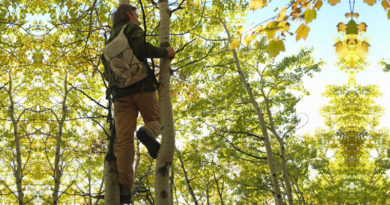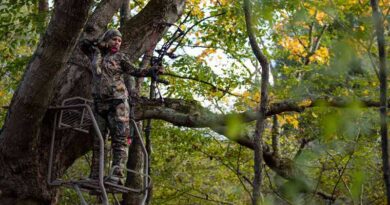How to Climb a Tree with Bare Hands?
Climbing a tree with bare hands can be challenging and requires a combination of strength, technique, and grip. Before attempting to climb, it’s recommended to build up your upper body strength and practice the proper technique on a lower branch or trunk. It’s important to choose the right tree and to wear appropriate clothing and gear for protection. It’s also important to note that climbing trees can be dangerous and should only be done with caution and proper safety measures. If you’re not confident in your ability to climb a tree with bare hands, it’s best to avoid it.
Choose the Right Tree
Before attempting to climb, it’s important to choose the right tree. You should look for the following characteristics in a tree:
Characteristics of a Good Tree to Climb
These are the characteristics of a good tree for climbing:
- Rough, sturdy bark: Look for a tree with rough, sturdy bark that provides plenty of grip for your hands and feet. Avoid trees with smooth or slippery bark, as it will be more difficult to climb.
- Close branches: Branches that are close together make it easier to maintain your balance and progress up the tree.
- Strong branches: Choose a tree with strong branches that can support your weight. Test the branches before you begin climbing to make sure they can hold you.
- Straight trunk: A straight trunk is easier to climb than one that is curved or contorted.
- Safe landing area: Make sure there is a safe landing area below the tree in case you fall.
Climbing trees can be dangerous, and you should only attempt it if you are confident in your abilities and have taken all necessary safety precautions. It’s best to avoid climbing a tree with bare hands if you’re not confident in your abilities.
Factors to Consider when Selecting a Tree
When selecting a tree to climb, consider the following factors:
- Safety: Make sure the tree is in a safe location and that there are no hazards such as overhead power lines, loose branches, or unstable roots.
- Accessibility: Choose a tree that is easily accessible, with low-hanging branches that are within reach.
- Strength: Make sure the tree is strong enough to support your weight. Avoid trees that are dead, diseased, or weakened, as they may break or fall.
- Height: Consider the height of the tree and make sure you are comfortable with the height you will reach.
- Environment: Make sure the tree is located in a peaceful and natural environment where you can enjoy the climb without interruptions.
- Legal issues: Make sure you have the necessary permissions to climb the tree and that it is not on private property or protected land.
With these factors in mind, you can select the right tree for climbing.
Types of Trees to Avoid
There are certain types of trees that you should avoid:
- Trees with smooth or slippery bark: Trees with smooth or slippery bark can be difficult to climb and provide little grip for your hands and feet.
- Trees with poisonous or irritant sap: Avoid climbing trees that produce sap that is poisonous or irritant to the skin. Examples include poison ivy, poison oak, and poison sumac.
- Dead or diseased trees: Trees that are dead, diseased, or weakened may break or fall, so it’s best to avoid climbing them.
- Trees with sharp branches: Avoid climbing trees with sharp branches that can scratch or cut your skin.
- Trees with low branches: Trees with low branches may not be strong enough to support your weight, and you could fall to the ground.
It’s important to be aware of your surroundings when climbing trees and to take the necessary safety precautions.
Preparing for the Climb
To prepare for a tree climb, consider the following steps:
Physical Preparation
Physical preparation is essential when climbing a tree. Building upper body strength and improving grip strength is critical for maintaining a firm grip on the tree as you climb. Furthermore, having good flexibility will enable you to reach higher branches while maintaining a better grip. You can also climb a tree with no branches.
Include push-ups, pull-ups, and finger grip exercises in your workout routine to build upper body strength. Practice grip strength exercises, such as using hand grippers or hanging from a bar, to improve grip strength. Improving your flexibility is essential for climbing because it allows you to reach higher branches while maintaining a better grip. Stretching and yoga should be incorporated into your workout routine to increase flexibility.
Tree climbing can also be physically demanding, so having good cardiovascular endurance is essential. In order to improve endurance, incorporate aerobic exercise into your workout routine, such as running or cycling. Practicing tree climbing with your hands can also help you gain confidence and get a feel for the movement. Begin with small trees and progress to larger trees as your skills improve.
Clothing and Gear to Wear
When climbing, it is critical to wear the proper gear and clothing. Wear athletic wear or outdoor gear that allows you to move freely because comfort and freedom of movement are essential. Wearing clothing that is too loose or heavy may get caught in branches and make climbing difficult or dangerous.
Consider wearing gloves to protect your hands from rough bark and sharp branches, in addition to comfortable clothing. A helmet can also provide additional protection in the event that you fall or hit your head on a branch. If you’re unsure about climbing a tree, a safety harness can provide an extra layer of protection in case you fall.
Stretching Exercises to Do Before Climbing
Stretching is an important part of preparing for a bare-handed tree climb. Warming up and stretching properly before climbing can help prevent injury and improve performance. Before climbing, consider the following stretching exercises:
- Arm and Shoulder Stretch: Stand with your arms extended overhead and interlock your fingers. Reach upward, hold for 10 to 15 seconds, and then release.
- Upper Back Stretch: Stand with your arms extended overhead and interlock your fingers. Push your arms forward and then upwards, hold for 10 to 15 seconds, and then release.
- Hamstring Stretch: Stand with your legs hip-width apart and reach down to touch your toes. Hold for 10 to 15 seconds and then release.
- Quad Stretch: Stand with one foot behind you and grab your ankle. Hold for 10 to 15 seconds and then switch sides.
- Wrist Stretch: Hold one arm out in front of you with your palm facing down. Use your other hand to gently pull your fingers down and hold for 10 to 15 seconds.
These stretching exercises can help your muscles prepare for the climb and improve your performance. Always listen to your body and only do stretches that are comfortable for you.
Use the Right Techniques
You can use the following techniques for a better experience:
Use your Legs for Propulsion
When climbing a tree, it is critical to use your legs for propulsion. Your legs provide the power to propel you up the tree, while your arms and hands grip and keep you balanced. Here’s how to use your legs to propel yourself up a tree:
- Foot-to-Hand Climb: This is the most basic technique. Start by finding a sturdy branch that is within reach, then reach up and grab the branch with both hands. Next, use your feet to push off the trunk and bring your knees up to your chest. Move one hand up to the next branch while maintaining a firm grip with the other hand. Repeat this process, alternating hands, until you reach the top of the tree.
- Stem Climb: This technique is useful when the tree trunk is too smooth to grip with your hands. Start by looking for a crack or crevice in the trunk that you can place your foot in. Push off the trunk with your foot and bring your knees up to your chest. With both hands, reach up and grab the next branch. Continue in this manner, alternating feet, until you reach the top of the tree.
- Straddle Climb: This technique is used when the trunk of the tree is too wide to grip with your hands. Start by straddling the trunk and placing your feet on either side. Reach up with both hands and grab the next branch. Pull yourself up and bring your knees to your chest. Repeat this process, alternating hands, until you reach the top of the tree.
- Flank Climb: This technique is used when the branches of the tree are too thin to grip with your hands. Start by standing on one side of the tree and reaching up to grab a branch with one hand. Use your feet to push off the trunk and bring your knees up to your chest. Reach up with your other hand and grab the next branch. Repeat this process, alternating hands, until you reach the top of the tree.
Remember to keep your balance and grip at all times, as well as to be cautious and aware of your surroundings while climbing. Before attempting to climb a tree, make sure you have the necessary safety equipment and understand the risks involved.
Grip Techniques for Better Handholds
Grip techniques are essential when climbing a tree. Maintaining your balance and supporting your weight while climbing requires a firm grip. Consider the following grip techniques when climbing a tree:
- Open-Hand Grip: This grip involves spreading your fingers wide and pressing them firmly against the trunk or branch. This grip is good for rough or irregular surfaces, as it provides a wider surface area for your hands to grip.
- Pinch Grip: This grip involves using your fingers and thumbs to grip onto a small surface or edge. This grip is good for smaller branches or narrow trunks, as it provides a strong and secure hold.
- Crimp Grip: This grip involves using the tips of your fingers to grip onto a small surface or edge. This grip is good for small or irregular surfaces, as it provides a secure hold while minimizing the size of your handhold.
- Side-Crimp Grip: This grip involves using the side of your hand to grip onto a surface or edge. This grip is good for wider surfaces, as it provides a secure hold while maximizing the size of your handhold.
It’s important to remember that the surface of the tree can be slippery, so make sure to grip the trunk or branch firmly to maintain your balance. Additionally, some trees have rough or sharp bark that can irritate or cut your skin, so consider wearing gloves for added protection.
Keep your Weight Centered
Keeping your weight centered is an important technique for maintaining stability when climbing a tree. Maintaining a centered weight distribution helps to ensure that you have a stable base of support and reduces the risk of slipping or falling.
As you climb, keep your weight centered over your feet and maintain a balanced, stable position. This will prevent you from falling or losing your balance, which could lead to injury. To achieve this stability, you should push yourself up the tree as much as possible with your legs. Because your legs are much stronger than your arms, they can support your weight more effectively. When reaching for the next branch or handhold, keep your body close to the tree trunk to keep your center of gravity stable.
Climb the Tree
Now you have learned all the techniques, it’s time to climb the tree:
Start Slowly and Test your Grip
Once you’re ready to start climbing, begin by testing your grip on the first branch. Apply just enough pressure to see if the branch will hold your weight, and if so, pull yourself up onto the branch. Repeat this process as you work your way up the tree, making sure to keep three points of contact with the tree at all times. This means having two hands and one foot, or two feet and one hand, on the tree at all times.
It’s also important to be mindful of your footing as you climb. Make sure to place your feet securely on each branch before shifting your weight, and avoid standing on the ends of branches, which are weaker and more prone to breaking.
Finally, if you’re feeling tired or uneasy, don’t hesitate to stop and take a break. The most important thing is to stay safe and have fun. With these tips in mind, you’ll be able to climb trees with confidence and enjoy the beautiful views from the top.
Gradually Working your Way Up
Gradually working your way up is a key technique for climbing a tree. This approach helps to reduce the risk of slipping or falling and ensures that you have a secure grip before making each move. Here’s how to gradually work your way up when climbing a tree:
- Start by locating a branch or trunk on which you can stand comfortably. Check that it can support your weight and is sturdy.
- Before making any moves, test your grip on the trunk or branch. To ensure that the handhold is secure and stable, apply gentle pressure to it.
- As you climb, begin by making small, gradual movements. Avoid making large or sudden movements as these can cause you to lose your balance.
- Before committing your weight to a new handhold, make sure to test it. To ensure that the handhold is secure and stable, apply gentle pressure to it.
- Gradually work your way up, making sure to maintain a steady pace and keep your weight centered over your feet at all times. This will help to maintain your balance and stability as you climb.
- Take as many breaks as you need to rest and catch your breath. Climbing a tree can be physically demanding, so take your time and avoid overexertion.
- Maintain your focus on the climb while remaining aware of your surroundings. Pay attention to your handholds and foot placement, and stay away from distractions that could cause you to lose your focus.
By gradually working your way up, you are greatly reducing the chance of falling.
Tips for Maintaining Balance
Maintaining balance is an important aspect. Here are some tips:
- Keep your weight centered over your feet: When climbing, make sure to keep your weight centered over your feet at all times. This will help you maintain your balance and stability as you climb.
- Use your legs for propulsion: Your legs are your strongest body parts, so make sure to use them to propel yourself upward. Use your legs to push off from the trunk or branch and make each move.
- Keep your body close to the tree: The closer you are to the tree, the easier it is to maintain your balance. So, when climbing, make sure to keep your body close to the tree and avoid reaching out for handholds.
- Look for sturdy handholds: Look for sturdy handholds that are large enough to support your weight. Avoid using small or thin branches, as they may break or give way under your weight.
- Stay focused: Climbing a tree requires focus and concentration. Make sure to keep your focus on the climb and avoid distractions that could cause you to lose your balance.
- Take your time: Climbing a tree can be physically demanding, so make sure to pace yourself and avoid overexerting yourself. Take breaks as needed to rest and catch your breath, and avoid rushing.
- Practice good posture: Good posture can help you maintain your balance when climbing a tree. Keep your back straight, your head up, and your knees slightly bent.
By taking these safety precautions, you are maintaining a good balance.
Conclusion
In conclusion, climbing a tree with bare hands can be a fun and challenging activity, but it also requires preparation, focus, and attention to safety. By following the guidelines outlined in this article, you can prepare yourself physically and mentally for the climb, select a safe and suitable tree, and use the proper techniques to make the climb successful.
Before attempting, consider your own physical abilities and limitations, as well as the characteristics of the tree. Warm up and stretch before climbing, dress appropriately, and focus on keeping your weight centered and your body close to the tree. You can climb a tree with confidence and enjoy the experience safely if you follow these tips and techniques.




